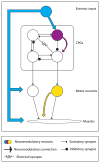Neuromodulation of neuronal circuits: back to the future - PubMed (original) (raw)
Review
Neuromodulation of neuronal circuits: back to the future
Eve Marder. Neuron. 2012.
Abstract
All nervous systems are subject to neuromodulation. Neuromodulators can be delivered as local hormones, as cotransmitters in projection neurons, and through the general circulation. Because neuromodulators can transform the intrinsic firing properties of circuit neurons and alter effective synaptic strength, neuromodulatory substances reconfigure neuronal circuits, often massively altering their output. Thus, the anatomical connectome provides a minimal structure and the neuromodulatory environment constructs and specifies the functional circuits that give rise to behavior.
Copyright © 2012 Elsevier Inc. All rights reserved.
Figures
Figure 1
Intrinsic and Extrinsic Modulation. Extrinsic modulation comes from outside the circuit or modulated target. Intrinsic modulation refers to neurons that are part of a circuit and release modulators that can alter the properties of other circuit elements. Drawing loosely after Katz and Frost (Katz and Frost, 1996).
Figure 2
Partial Summary of Neuromodulation of the crab stomatogastric ganglion (STG). The STG sits anterior to the heart within an artery that brings modulatory amines and peptides from neurosecretory structures such as the pericardial organs (bottom list). 25 pairs of descending modulatory neurons bring a host of substances into the neuropil of the STG (right). The number of family members of the neuropeptides are shown in parentheses. Figure was made by D. Bucher, summarizing work from the Li and Stemmler labs and numerous collaborators.
Figure 3
Multiple neuromodulators can activate different forms of the pyloric rhythm. In each panel the top two traces are intracellular recordings from the Lateral Pyloric (LP) and Pyloric Dilator (PD) neurons. The bottom trace is an extracellular recording from the lateral ventricular nerve (lvn) that carries the axons of the LP, PD, and Pyloric (PY) neurons. (Marder and Weimann, 1992).
Figure 4
Modulatory reconfiguration of circuits. A) Three different proctolin-containing modulatory neurons each evoke different changes in STG motor patterns. (Blitz et al., 1999; Nusbaum et al., 2001). B) Bath application of RPCH constructs a conjoint rhythm from previously separate cardiac sac and gastric mill circuit elements. Modified from Dickinson et al (1990).
Figure 5
Aminergic modulation of pyloric circuit elements. A) The actions of dopamine on ionic currents in the indicated neurons are shown. From (Harris-Warrick, 2011). B) Graded IPSPs evoked in the postsynaptic PD neuron by depolarization of the LP neuron in control (black traces), dopamine (red), octopamine (blue) and serotonin (green). Modified from Johnston et al (2011).
Figure 6
Effects of modulatory substances on a bursting pacemaker neuron, A) Intracellular recordings from the isolated Anterior Burster (AB) neuron in control and proctolin. Modified from Hooper and Marder (1987). Notice the increase in amplitude without change in baseline. B) AB neuron in response to nicotine and pilocarpine.
Figure 7
Multiple modulators act on the same neuron and converge onto the same current. A) Puff applications of the modulators indicated onto intracellularly recorded LP neuron. (Swensen and Marder, 2000). B) Voltage-clamp recordings of inward currents evoked by proctolin and CabTRP1a. Top traces, puff of proctolin elicited an inward current. When CabTRP1a was placed in the bath, eliciting a steady-state inward current, a puff of proctolin produced only a very small additional inward current. Bottom traces, reverse experiment. (Swensen and Marder, 2000).
Similar articles
- Neuromodulation of circuits with variable parameters: single neurons and small circuits reveal principles of state-dependent and robust neuromodulation.
Marder E, O'Leary T, Shruti S. Marder E, et al. Annu Rev Neurosci. 2014;37:329-46. doi: 10.1146/annurev-neuro-071013-013958. Annu Rev Neurosci. 2014. PMID: 25032499 Review. - Beyond the connectome: how neuromodulators shape neural circuits.
Bargmann CI. Bargmann CI. Bioessays. 2012 Jun;34(6):458-65. doi: 10.1002/bies.201100185. Epub 2012 Mar 6. Bioessays. 2012. PMID: 22396302 - Neuromodulation in invertebrate sensory systems: from biophysics to behavior.
Birmingham JT, Tauck DL. Birmingham JT, et al. J Exp Biol. 2003 Oct;206(Pt 20):3541-6. doi: 10.1242/jeb.00601. J Exp Biol. 2003. PMID: 12966045 Review. - Cholinergic neuromodulation of inhibitory interneurons facilitates functional integration in whole-brain models.
Coronel-Oliveros C, Cofré R, Orio P. Coronel-Oliveros C, et al. PLoS Comput Biol. 2021 Feb 18;17(2):e1008737. doi: 10.1371/journal.pcbi.1008737. eCollection 2021 Feb. PLoS Comput Biol. 2021. PMID: 33600402 Free PMC article. - Actions of identified neuromodulatory neurons in a simple motor system.
Katz PS, Harris-Warrick RM. Katz PS, et al. Trends Neurosci. 1990 Sep;13(9):367-73. doi: 10.1016/0166-2236(90)90021-2. Trends Neurosci. 1990. PMID: 1699326 Review.
Cited by
- Homeostatic Activity-Dependent Tuning of Recurrent Networks for Robust Propagation of Activity.
Gjorgjieva J, Evers JF, Eglen SJ. Gjorgjieva J, et al. J Neurosci. 2016 Mar 30;36(13):3722-34. doi: 10.1523/JNEUROSCI.2511-15.2016. J Neurosci. 2016. PMID: 27030758 Free PMC article. - Global view of the evolution and diversity of metazoan neuropeptide signaling.
Jékely G. Jékely G. Proc Natl Acad Sci U S A. 2013 May 21;110(21):8702-7. doi: 10.1073/pnas.1221833110. Epub 2013 May 1. Proc Natl Acad Sci U S A. 2013. PMID: 23637342 Free PMC article. - Neurons within the same network independently achieve conserved output by differentially balancing variable conductance magnitudes.
Ransdell JL, Nair SS, Schulz DJ. Ransdell JL, et al. J Neurosci. 2013 Jun 12;33(24):9950-6. doi: 10.1523/JNEUROSCI.1095-13.2013. J Neurosci. 2013. PMID: 23761890 Free PMC article. - Modulation by Neuropeptides with Overlapping Targets Results in Functional Overlap in Oscillatory Circuit Activation.
Cronin EM, Schneider AC, Nadim F, Bucher D. Cronin EM, et al. J Neurosci. 2024 Jan 3;44(1):e1201232023. doi: 10.1523/JNEUROSCI.1201-23.2023. J Neurosci. 2024. PMID: 37968117 Free PMC article. - Cholinergic modulation of hippocampal network function.
Teles-Grilo Ruivo LM, Mellor JR. Teles-Grilo Ruivo LM, et al. Front Synaptic Neurosci. 2013 Jul 30;5:2. doi: 10.3389/fnsyn.2013.00002. eCollection 2013. Front Synaptic Neurosci. 2013. PMID: 23908628 Free PMC article.
References
- Adams ME, O’Shea M. Peptide cotransmitter at a neuromuscular junction. Science. 1983;221:286–288. - PubMed
- Bargmann CI. Beyond the connectome: how neuromodulators shape neural circuits. Bioessays. 2012;34:458–465. - PubMed
- Barker DL, Molinoff PB, Kravitz EA. Octopamine in the lobster nervous system. Nature New Biol. 1972;236:61–62. - PubMed
Publication types
MeSH terms
Substances
LinkOut - more resources
Full Text Sources






